Poverty: A Global Issue, Approaches, Sustainability, and Implications
VerifiedAdded on 2021/04/21
|14
|5348
|192
Essay
AI Summary
This essay delves into the multifaceted issue of global poverty, defining it as a complex concept encompassing economic, social, and political elements, and exploring its various dimensions. It examines both relative and absolute poverty, highlighting the global prevalence and the progress made in poverty reduction. The essay discusses the connection between poverty and sustainable development, emphasizing the need for environmental sustainability to eradicate poverty. It explores different approaches to poverty, including monetary, capability, social exclusion, and participatory approaches, and examines the principle of equity and poverty eradication in relation to sustainable development. The essay underscores the importance of addressing poverty to achieve sustainable development goals and improve the quality of life globally.
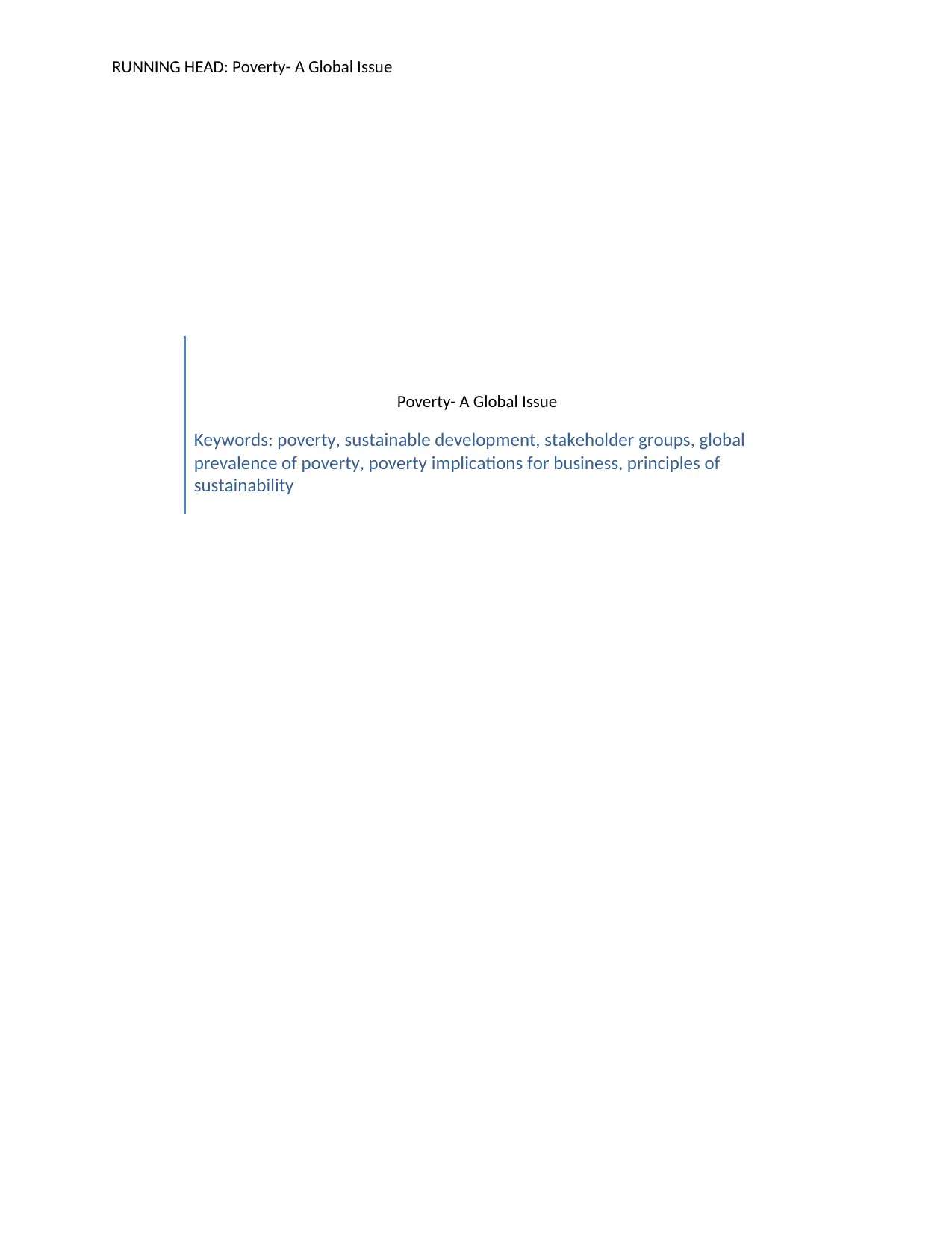
RUNNING HEAD: Poverty- A Global Issue
Poverty- A Global Issue
Keywords: poverty, sustainable development, stakeholder groups, global
prevalence of poverty, poverty implications for business, principles of
sustainability
Poverty- A Global Issue
Keywords: poverty, sustainable development, stakeholder groups, global
prevalence of poverty, poverty implications for business, principles of
sustainability
Paraphrase This Document
Need a fresh take? Get an instant paraphrase of this document with our AI Paraphraser
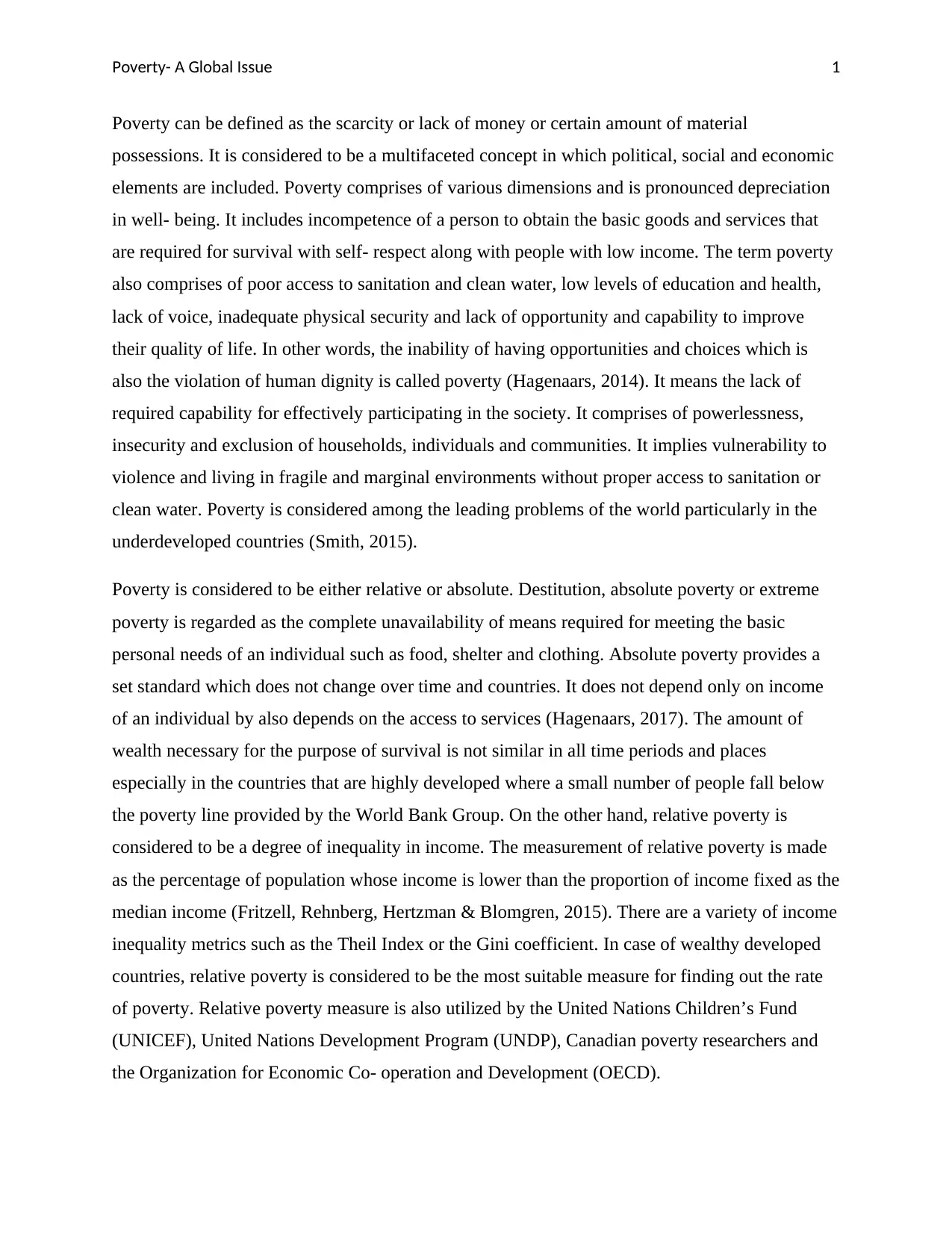
Poverty- A Global Issue 1
Poverty can be defined as the scarcity or lack of money or certain amount of material
possessions. It is considered to be a multifaceted concept in which political, social and economic
elements are included. Poverty comprises of various dimensions and is pronounced depreciation
in well- being. It includes incompetence of a person to obtain the basic goods and services that
are required for survival with self- respect along with people with low income. The term poverty
also comprises of poor access to sanitation and clean water, low levels of education and health,
lack of voice, inadequate physical security and lack of opportunity and capability to improve
their quality of life. In other words, the inability of having opportunities and choices which is
also the violation of human dignity is called poverty (Hagenaars, 2014). It means the lack of
required capability for effectively participating in the society. It comprises of powerlessness,
insecurity and exclusion of households, individuals and communities. It implies vulnerability to
violence and living in fragile and marginal environments without proper access to sanitation or
clean water. Poverty is considered among the leading problems of the world particularly in the
underdeveloped countries (Smith, 2015).
Poverty is considered to be either relative or absolute. Destitution, absolute poverty or extreme
poverty is regarded as the complete unavailability of means required for meeting the basic
personal needs of an individual such as food, shelter and clothing. Absolute poverty provides a
set standard which does not change over time and countries. It does not depend only on income
of an individual by also depends on the access to services (Hagenaars, 2017). The amount of
wealth necessary for the purpose of survival is not similar in all time periods and places
especially in the countries that are highly developed where a small number of people fall below
the poverty line provided by the World Bank Group. On the other hand, relative poverty is
considered to be a degree of inequality in income. The measurement of relative poverty is made
as the percentage of population whose income is lower than the proportion of income fixed as the
median income (Fritzell, Rehnberg, Hertzman & Blomgren, 2015). There are a variety of income
inequality metrics such as the Theil Index or the Gini coefficient. In case of wealthy developed
countries, relative poverty is considered to be the most suitable measure for finding out the rate
of poverty. Relative poverty measure is also utilized by the United Nations Children’s Fund
(UNICEF), United Nations Development Program (UNDP), Canadian poverty researchers and
the Organization for Economic Co- operation and Development (OECD).
Poverty can be defined as the scarcity or lack of money or certain amount of material
possessions. It is considered to be a multifaceted concept in which political, social and economic
elements are included. Poverty comprises of various dimensions and is pronounced depreciation
in well- being. It includes incompetence of a person to obtain the basic goods and services that
are required for survival with self- respect along with people with low income. The term poverty
also comprises of poor access to sanitation and clean water, low levels of education and health,
lack of voice, inadequate physical security and lack of opportunity and capability to improve
their quality of life. In other words, the inability of having opportunities and choices which is
also the violation of human dignity is called poverty (Hagenaars, 2014). It means the lack of
required capability for effectively participating in the society. It comprises of powerlessness,
insecurity and exclusion of households, individuals and communities. It implies vulnerability to
violence and living in fragile and marginal environments without proper access to sanitation or
clean water. Poverty is considered among the leading problems of the world particularly in the
underdeveloped countries (Smith, 2015).
Poverty is considered to be either relative or absolute. Destitution, absolute poverty or extreme
poverty is regarded as the complete unavailability of means required for meeting the basic
personal needs of an individual such as food, shelter and clothing. Absolute poverty provides a
set standard which does not change over time and countries. It does not depend only on income
of an individual by also depends on the access to services (Hagenaars, 2017). The amount of
wealth necessary for the purpose of survival is not similar in all time periods and places
especially in the countries that are highly developed where a small number of people fall below
the poverty line provided by the World Bank Group. On the other hand, relative poverty is
considered to be a degree of inequality in income. The measurement of relative poverty is made
as the percentage of population whose income is lower than the proportion of income fixed as the
median income (Fritzell, Rehnberg, Hertzman & Blomgren, 2015). There are a variety of income
inequality metrics such as the Theil Index or the Gini coefficient. In case of wealthy developed
countries, relative poverty is considered to be the most suitable measure for finding out the rate
of poverty. Relative poverty measure is also utilized by the United Nations Children’s Fund
(UNICEF), United Nations Development Program (UNDP), Canadian poverty researchers and
the Organization for Economic Co- operation and Development (OECD).
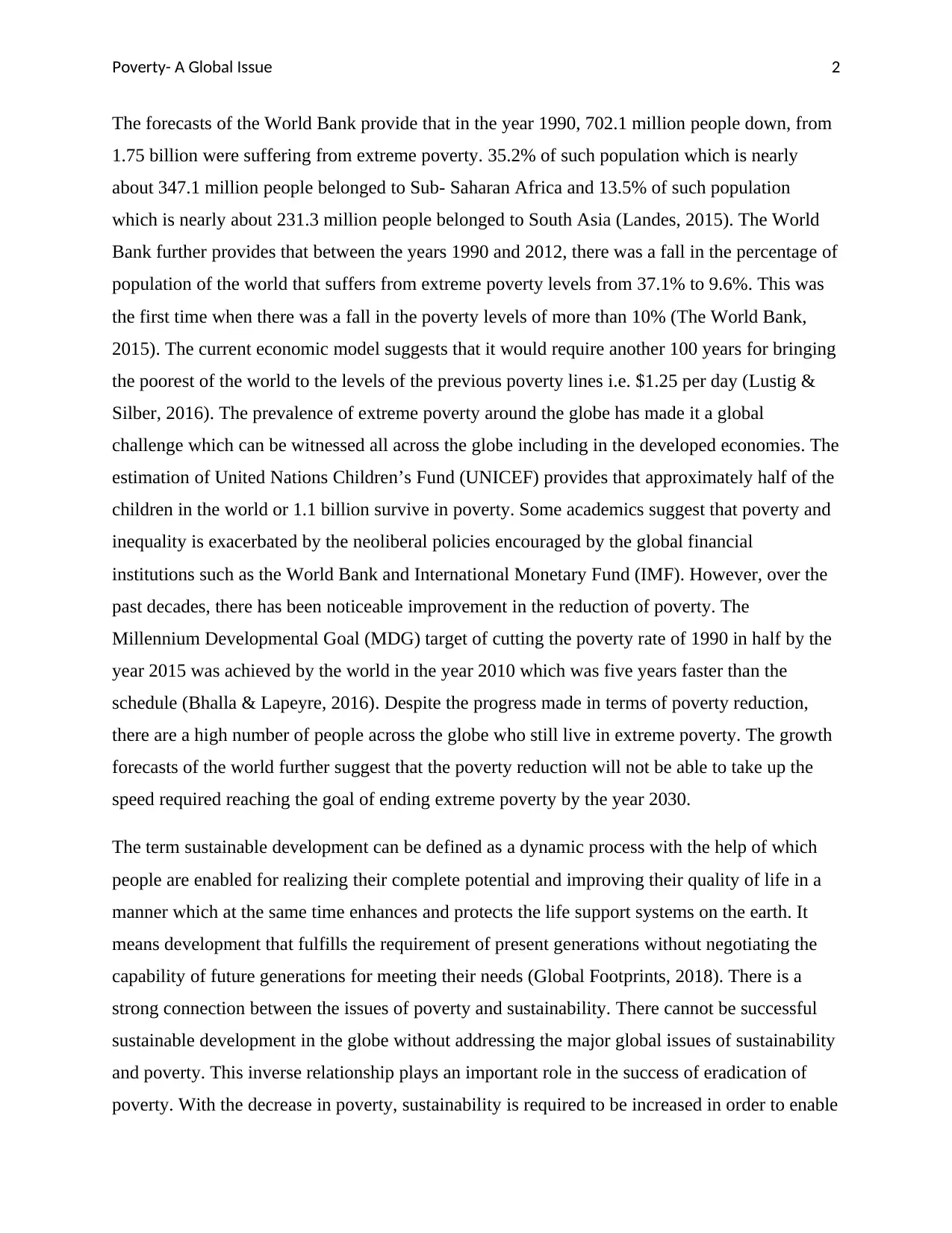
Poverty- A Global Issue 2
The forecasts of the World Bank provide that in the year 1990, 702.1 million people down, from
1.75 billion were suffering from extreme poverty. 35.2% of such population which is nearly
about 347.1 million people belonged to Sub- Saharan Africa and 13.5% of such population
which is nearly about 231.3 million people belonged to South Asia (Landes, 2015). The World
Bank further provides that between the years 1990 and 2012, there was a fall in the percentage of
population of the world that suffers from extreme poverty levels from 37.1% to 9.6%. This was
the first time when there was a fall in the poverty levels of more than 10% (The World Bank,
2015). The current economic model suggests that it would require another 100 years for bringing
the poorest of the world to the levels of the previous poverty lines i.e. $1.25 per day (Lustig &
Silber, 2016). The prevalence of extreme poverty around the globe has made it a global
challenge which can be witnessed all across the globe including in the developed economies. The
estimation of United Nations Children’s Fund (UNICEF) provides that approximately half of the
children in the world or 1.1 billion survive in poverty. Some academics suggest that poverty and
inequality is exacerbated by the neoliberal policies encouraged by the global financial
institutions such as the World Bank and International Monetary Fund (IMF). However, over the
past decades, there has been noticeable improvement in the reduction of poverty. The
Millennium Developmental Goal (MDG) target of cutting the poverty rate of 1990 in half by the
year 2015 was achieved by the world in the year 2010 which was five years faster than the
schedule (Bhalla & Lapeyre, 2016). Despite the progress made in terms of poverty reduction,
there are a high number of people across the globe who still live in extreme poverty. The growth
forecasts of the world further suggest that the poverty reduction will not be able to take up the
speed required reaching the goal of ending extreme poverty by the year 2030.
The term sustainable development can be defined as a dynamic process with the help of which
people are enabled for realizing their complete potential and improving their quality of life in a
manner which at the same time enhances and protects the life support systems on the earth. It
means development that fulfills the requirement of present generations without negotiating the
capability of future generations for meeting their needs (Global Footprints, 2018). There is a
strong connection between the issues of poverty and sustainability. There cannot be successful
sustainable development in the globe without addressing the major global issues of sustainability
and poverty. This inverse relationship plays an important role in the success of eradication of
poverty. With the decrease in poverty, sustainability is required to be increased in order to enable
The forecasts of the World Bank provide that in the year 1990, 702.1 million people down, from
1.75 billion were suffering from extreme poverty. 35.2% of such population which is nearly
about 347.1 million people belonged to Sub- Saharan Africa and 13.5% of such population
which is nearly about 231.3 million people belonged to South Asia (Landes, 2015). The World
Bank further provides that between the years 1990 and 2012, there was a fall in the percentage of
population of the world that suffers from extreme poverty levels from 37.1% to 9.6%. This was
the first time when there was a fall in the poverty levels of more than 10% (The World Bank,
2015). The current economic model suggests that it would require another 100 years for bringing
the poorest of the world to the levels of the previous poverty lines i.e. $1.25 per day (Lustig &
Silber, 2016). The prevalence of extreme poverty around the globe has made it a global
challenge which can be witnessed all across the globe including in the developed economies. The
estimation of United Nations Children’s Fund (UNICEF) provides that approximately half of the
children in the world or 1.1 billion survive in poverty. Some academics suggest that poverty and
inequality is exacerbated by the neoliberal policies encouraged by the global financial
institutions such as the World Bank and International Monetary Fund (IMF). However, over the
past decades, there has been noticeable improvement in the reduction of poverty. The
Millennium Developmental Goal (MDG) target of cutting the poverty rate of 1990 in half by the
year 2015 was achieved by the world in the year 2010 which was five years faster than the
schedule (Bhalla & Lapeyre, 2016). Despite the progress made in terms of poverty reduction,
there are a high number of people across the globe who still live in extreme poverty. The growth
forecasts of the world further suggest that the poverty reduction will not be able to take up the
speed required reaching the goal of ending extreme poverty by the year 2030.
The term sustainable development can be defined as a dynamic process with the help of which
people are enabled for realizing their complete potential and improving their quality of life in a
manner which at the same time enhances and protects the life support systems on the earth. It
means development that fulfills the requirement of present generations without negotiating the
capability of future generations for meeting their needs (Global Footprints, 2018). There is a
strong connection between the issues of poverty and sustainability. There cannot be successful
sustainable development in the globe without addressing the major global issues of sustainability
and poverty. This inverse relationship plays an important role in the success of eradication of
poverty. With the decrease in poverty, sustainability is required to be increased in order to enable
⊘ This is a preview!⊘
Do you want full access?
Subscribe today to unlock all pages.

Trusted by 1+ million students worldwide
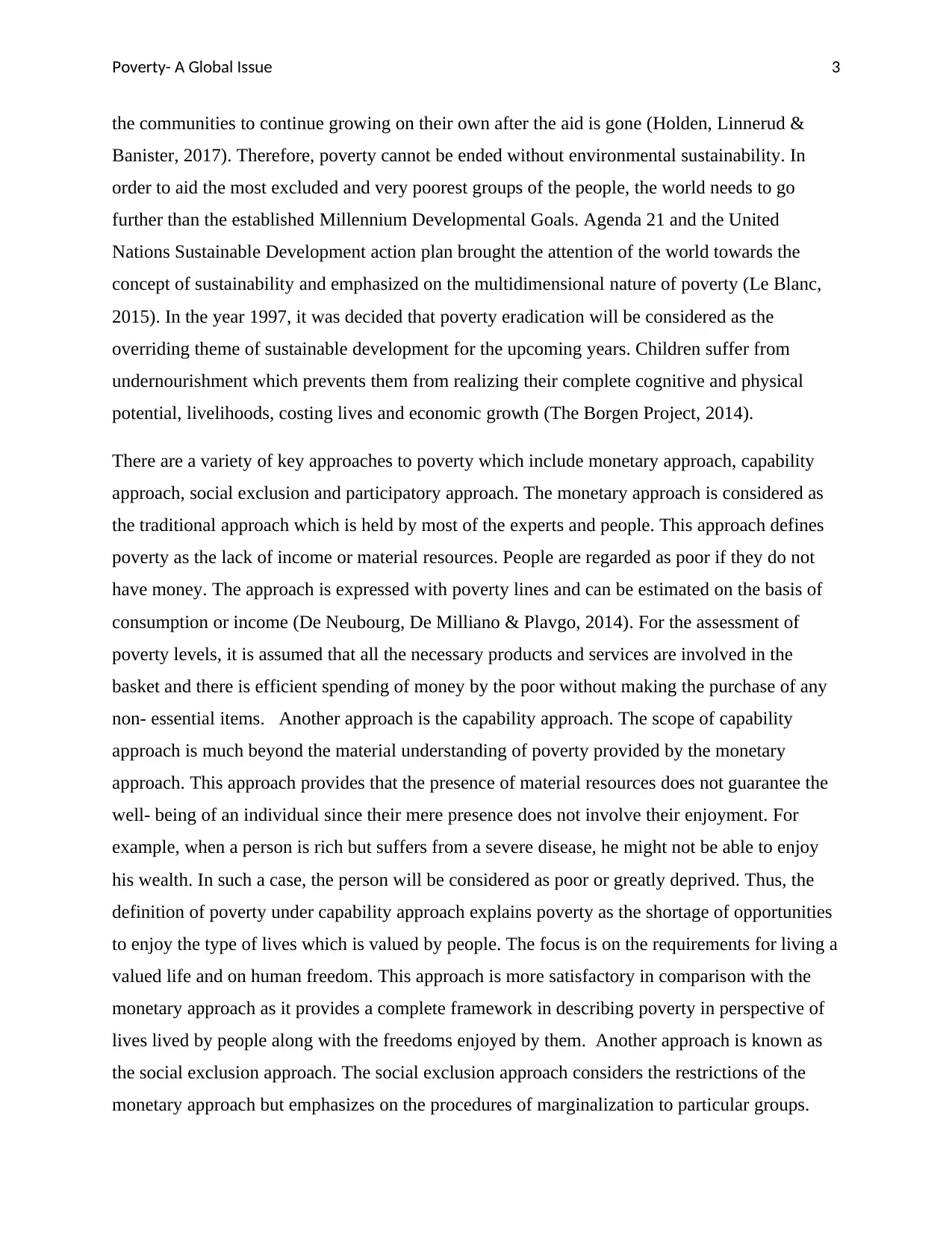
Poverty- A Global Issue 3
the communities to continue growing on their own after the aid is gone (Holden, Linnerud &
Banister, 2017). Therefore, poverty cannot be ended without environmental sustainability. In
order to aid the most excluded and very poorest groups of the people, the world needs to go
further than the established Millennium Developmental Goals. Agenda 21 and the United
Nations Sustainable Development action plan brought the attention of the world towards the
concept of sustainability and emphasized on the multidimensional nature of poverty (Le Blanc,
2015). In the year 1997, it was decided that poverty eradication will be considered as the
overriding theme of sustainable development for the upcoming years. Children suffer from
undernourishment which prevents them from realizing their complete cognitive and physical
potential, livelihoods, costing lives and economic growth (The Borgen Project, 2014).
There are a variety of key approaches to poverty which include monetary approach, capability
approach, social exclusion and participatory approach. The monetary approach is considered as
the traditional approach which is held by most of the experts and people. This approach defines
poverty as the lack of income or material resources. People are regarded as poor if they do not
have money. The approach is expressed with poverty lines and can be estimated on the basis of
consumption or income (De Neubourg, De Milliano & Plavgo, 2014). For the assessment of
poverty levels, it is assumed that all the necessary products and services are involved in the
basket and there is efficient spending of money by the poor without making the purchase of any
non- essential items. Another approach is the capability approach. The scope of capability
approach is much beyond the material understanding of poverty provided by the monetary
approach. This approach provides that the presence of material resources does not guarantee the
well- being of an individual since their mere presence does not involve their enjoyment. For
example, when a person is rich but suffers from a severe disease, he might not be able to enjoy
his wealth. In such a case, the person will be considered as poor or greatly deprived. Thus, the
definition of poverty under capability approach explains poverty as the shortage of opportunities
to enjoy the type of lives which is valued by people. The focus is on the requirements for living a
valued life and on human freedom. This approach is more satisfactory in comparison with the
monetary approach as it provides a complete framework in describing poverty in perspective of
lives lived by people along with the freedoms enjoyed by them. Another approach is known as
the social exclusion approach. The social exclusion approach considers the restrictions of the
monetary approach but emphasizes on the procedures of marginalization to particular groups.
the communities to continue growing on their own after the aid is gone (Holden, Linnerud &
Banister, 2017). Therefore, poverty cannot be ended without environmental sustainability. In
order to aid the most excluded and very poorest groups of the people, the world needs to go
further than the established Millennium Developmental Goals. Agenda 21 and the United
Nations Sustainable Development action plan brought the attention of the world towards the
concept of sustainability and emphasized on the multidimensional nature of poverty (Le Blanc,
2015). In the year 1997, it was decided that poverty eradication will be considered as the
overriding theme of sustainable development for the upcoming years. Children suffer from
undernourishment which prevents them from realizing their complete cognitive and physical
potential, livelihoods, costing lives and economic growth (The Borgen Project, 2014).
There are a variety of key approaches to poverty which include monetary approach, capability
approach, social exclusion and participatory approach. The monetary approach is considered as
the traditional approach which is held by most of the experts and people. This approach defines
poverty as the lack of income or material resources. People are regarded as poor if they do not
have money. The approach is expressed with poverty lines and can be estimated on the basis of
consumption or income (De Neubourg, De Milliano & Plavgo, 2014). For the assessment of
poverty levels, it is assumed that all the necessary products and services are involved in the
basket and there is efficient spending of money by the poor without making the purchase of any
non- essential items. Another approach is the capability approach. The scope of capability
approach is much beyond the material understanding of poverty provided by the monetary
approach. This approach provides that the presence of material resources does not guarantee the
well- being of an individual since their mere presence does not involve their enjoyment. For
example, when a person is rich but suffers from a severe disease, he might not be able to enjoy
his wealth. In such a case, the person will be considered as poor or greatly deprived. Thus, the
definition of poverty under capability approach explains poverty as the shortage of opportunities
to enjoy the type of lives which is valued by people. The focus is on the requirements for living a
valued life and on human freedom. This approach is more satisfactory in comparison with the
monetary approach as it provides a complete framework in describing poverty in perspective of
lives lived by people along with the freedoms enjoyed by them. Another approach is known as
the social exclusion approach. The social exclusion approach considers the restrictions of the
monetary approach but emphasizes on the procedures of marginalization to particular groups.
Paraphrase This Document
Need a fresh take? Get an instant paraphrase of this document with our AI Paraphraser
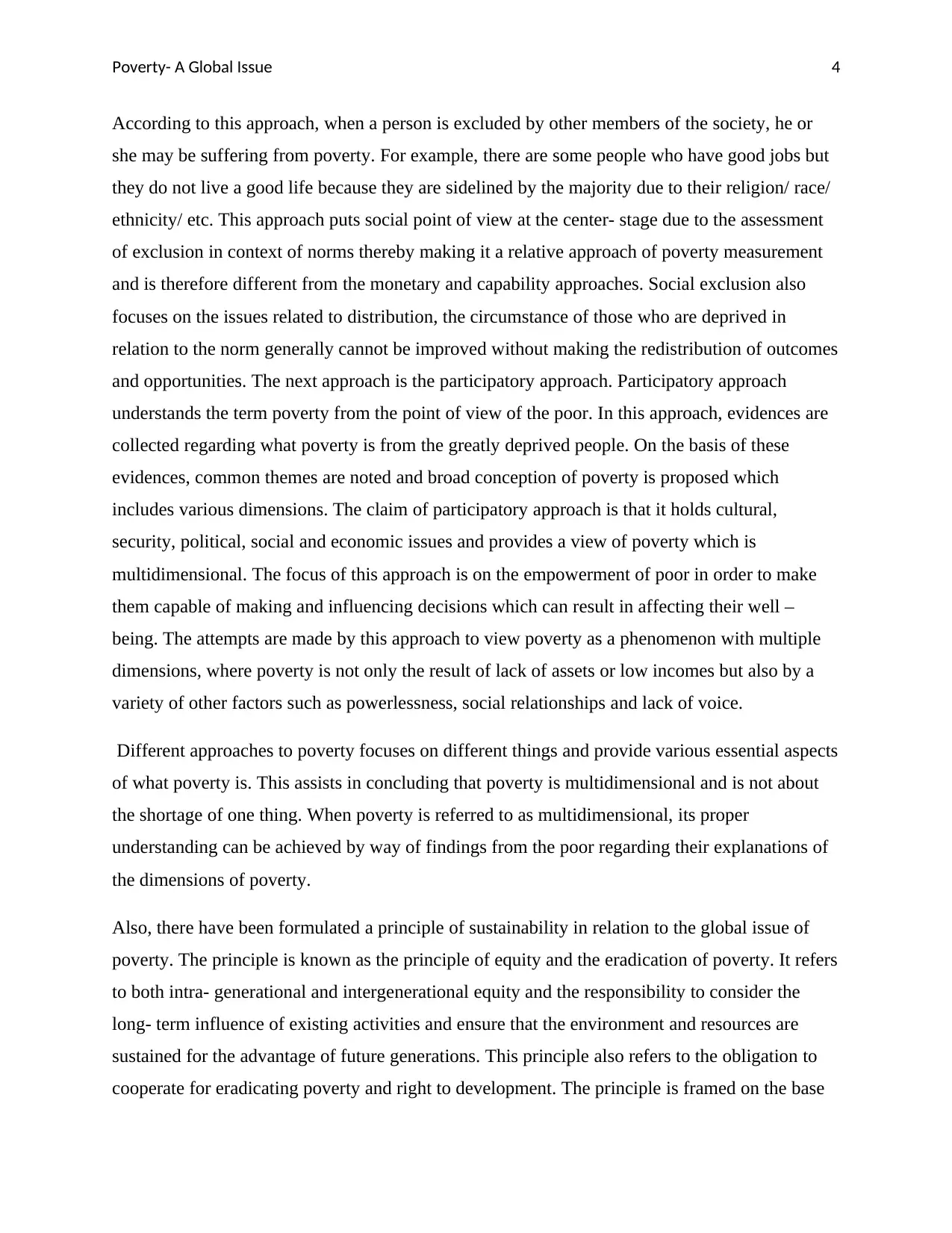
Poverty- A Global Issue 4
According to this approach, when a person is excluded by other members of the society, he or
she may be suffering from poverty. For example, there are some people who have good jobs but
they do not live a good life because they are sidelined by the majority due to their religion/ race/
ethnicity/ etc. This approach puts social point of view at the center- stage due to the assessment
of exclusion in context of norms thereby making it a relative approach of poverty measurement
and is therefore different from the monetary and capability approaches. Social exclusion also
focuses on the issues related to distribution, the circumstance of those who are deprived in
relation to the norm generally cannot be improved without making the redistribution of outcomes
and opportunities. The next approach is the participatory approach. Participatory approach
understands the term poverty from the point of view of the poor. In this approach, evidences are
collected regarding what poverty is from the greatly deprived people. On the basis of these
evidences, common themes are noted and broad conception of poverty is proposed which
includes various dimensions. The claim of participatory approach is that it holds cultural,
security, political, social and economic issues and provides a view of poverty which is
multidimensional. The focus of this approach is on the empowerment of poor in order to make
them capable of making and influencing decisions which can result in affecting their well –
being. The attempts are made by this approach to view poverty as a phenomenon with multiple
dimensions, where poverty is not only the result of lack of assets or low incomes but also by a
variety of other factors such as powerlessness, social relationships and lack of voice.
Different approaches to poverty focuses on different things and provide various essential aspects
of what poverty is. This assists in concluding that poverty is multidimensional and is not about
the shortage of one thing. When poverty is referred to as multidimensional, its proper
understanding can be achieved by way of findings from the poor regarding their explanations of
the dimensions of poverty.
Also, there have been formulated a principle of sustainability in relation to the global issue of
poverty. The principle is known as the principle of equity and the eradication of poverty. It refers
to both intra- generational and intergenerational equity and the responsibility to consider the
long- term influence of existing activities and ensure that the environment and resources are
sustained for the advantage of future generations. This principle also refers to the obligation to
cooperate for eradicating poverty and right to development. The principle is framed on the base
According to this approach, when a person is excluded by other members of the society, he or
she may be suffering from poverty. For example, there are some people who have good jobs but
they do not live a good life because they are sidelined by the majority due to their religion/ race/
ethnicity/ etc. This approach puts social point of view at the center- stage due to the assessment
of exclusion in context of norms thereby making it a relative approach of poverty measurement
and is therefore different from the monetary and capability approaches. Social exclusion also
focuses on the issues related to distribution, the circumstance of those who are deprived in
relation to the norm generally cannot be improved without making the redistribution of outcomes
and opportunities. The next approach is the participatory approach. Participatory approach
understands the term poverty from the point of view of the poor. In this approach, evidences are
collected regarding what poverty is from the greatly deprived people. On the basis of these
evidences, common themes are noted and broad conception of poverty is proposed which
includes various dimensions. The claim of participatory approach is that it holds cultural,
security, political, social and economic issues and provides a view of poverty which is
multidimensional. The focus of this approach is on the empowerment of poor in order to make
them capable of making and influencing decisions which can result in affecting their well –
being. The attempts are made by this approach to view poverty as a phenomenon with multiple
dimensions, where poverty is not only the result of lack of assets or low incomes but also by a
variety of other factors such as powerlessness, social relationships and lack of voice.
Different approaches to poverty focuses on different things and provide various essential aspects
of what poverty is. This assists in concluding that poverty is multidimensional and is not about
the shortage of one thing. When poverty is referred to as multidimensional, its proper
understanding can be achieved by way of findings from the poor regarding their explanations of
the dimensions of poverty.
Also, there have been formulated a principle of sustainability in relation to the global issue of
poverty. The principle is known as the principle of equity and the eradication of poverty. It refers
to both intra- generational and intergenerational equity and the responsibility to consider the
long- term influence of existing activities and ensure that the environment and resources are
sustained for the advantage of future generations. This principle also refers to the obligation to
cooperate for eradicating poverty and right to development. The principle is framed on the base
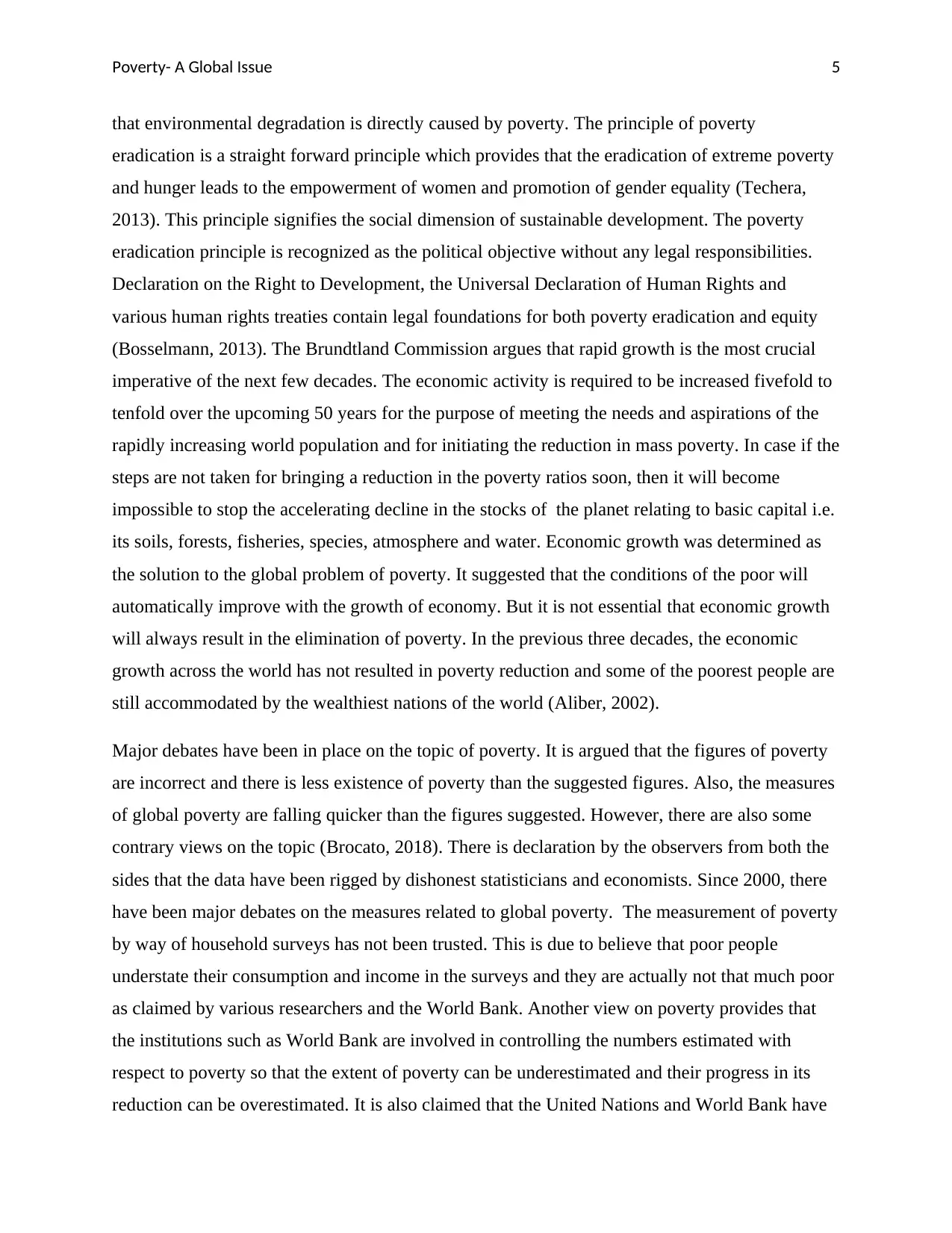
Poverty- A Global Issue 5
that environmental degradation is directly caused by poverty. The principle of poverty
eradication is a straight forward principle which provides that the eradication of extreme poverty
and hunger leads to the empowerment of women and promotion of gender equality (Techera,
2013). This principle signifies the social dimension of sustainable development. The poverty
eradication principle is recognized as the political objective without any legal responsibilities.
Declaration on the Right to Development, the Universal Declaration of Human Rights and
various human rights treaties contain legal foundations for both poverty eradication and equity
(Bosselmann, 2013). The Brundtland Commission argues that rapid growth is the most crucial
imperative of the next few decades. The economic activity is required to be increased fivefold to
tenfold over the upcoming 50 years for the purpose of meeting the needs and aspirations of the
rapidly increasing world population and for initiating the reduction in mass poverty. In case if the
steps are not taken for bringing a reduction in the poverty ratios soon, then it will become
impossible to stop the accelerating decline in the stocks of the planet relating to basic capital i.e.
its soils, forests, fisheries, species, atmosphere and water. Economic growth was determined as
the solution to the global problem of poverty. It suggested that the conditions of the poor will
automatically improve with the growth of economy. But it is not essential that economic growth
will always result in the elimination of poverty. In the previous three decades, the economic
growth across the world has not resulted in poverty reduction and some of the poorest people are
still accommodated by the wealthiest nations of the world (Aliber, 2002).
Major debates have been in place on the topic of poverty. It is argued that the figures of poverty
are incorrect and there is less existence of poverty than the suggested figures. Also, the measures
of global poverty are falling quicker than the figures suggested. However, there are also some
contrary views on the topic (Brocato, 2018). There is declaration by the observers from both the
sides that the data have been rigged by dishonest statisticians and economists. Since 2000, there
have been major debates on the measures related to global poverty. The measurement of poverty
by way of household surveys has not been trusted. This is due to believe that poor people
understate their consumption and income in the surveys and they are actually not that much poor
as claimed by various researchers and the World Bank. Another view on poverty provides that
the institutions such as World Bank are involved in controlling the numbers estimated with
respect to poverty so that the extent of poverty can be underestimated and their progress in its
reduction can be overestimated. It is also claimed that the United Nations and World Bank have
that environmental degradation is directly caused by poverty. The principle of poverty
eradication is a straight forward principle which provides that the eradication of extreme poverty
and hunger leads to the empowerment of women and promotion of gender equality (Techera,
2013). This principle signifies the social dimension of sustainable development. The poverty
eradication principle is recognized as the political objective without any legal responsibilities.
Declaration on the Right to Development, the Universal Declaration of Human Rights and
various human rights treaties contain legal foundations for both poverty eradication and equity
(Bosselmann, 2013). The Brundtland Commission argues that rapid growth is the most crucial
imperative of the next few decades. The economic activity is required to be increased fivefold to
tenfold over the upcoming 50 years for the purpose of meeting the needs and aspirations of the
rapidly increasing world population and for initiating the reduction in mass poverty. In case if the
steps are not taken for bringing a reduction in the poverty ratios soon, then it will become
impossible to stop the accelerating decline in the stocks of the planet relating to basic capital i.e.
its soils, forests, fisheries, species, atmosphere and water. Economic growth was determined as
the solution to the global problem of poverty. It suggested that the conditions of the poor will
automatically improve with the growth of economy. But it is not essential that economic growth
will always result in the elimination of poverty. In the previous three decades, the economic
growth across the world has not resulted in poverty reduction and some of the poorest people are
still accommodated by the wealthiest nations of the world (Aliber, 2002).
Major debates have been in place on the topic of poverty. It is argued that the figures of poverty
are incorrect and there is less existence of poverty than the suggested figures. Also, the measures
of global poverty are falling quicker than the figures suggested. However, there are also some
contrary views on the topic (Brocato, 2018). There is declaration by the observers from both the
sides that the data have been rigged by dishonest statisticians and economists. Since 2000, there
have been major debates on the measures related to global poverty. The measurement of poverty
by way of household surveys has not been trusted. This is due to believe that poor people
understate their consumption and income in the surveys and they are actually not that much poor
as claimed by various researchers and the World Bank. Another view on poverty provides that
the institutions such as World Bank are involved in controlling the numbers estimated with
respect to poverty so that the extent of poverty can be underestimated and their progress in its
reduction can be overestimated. It is also claimed that the United Nations and World Bank have
⊘ This is a preview!⊘
Do you want full access?
Subscribe today to unlock all pages.

Trusted by 1+ million students worldwide
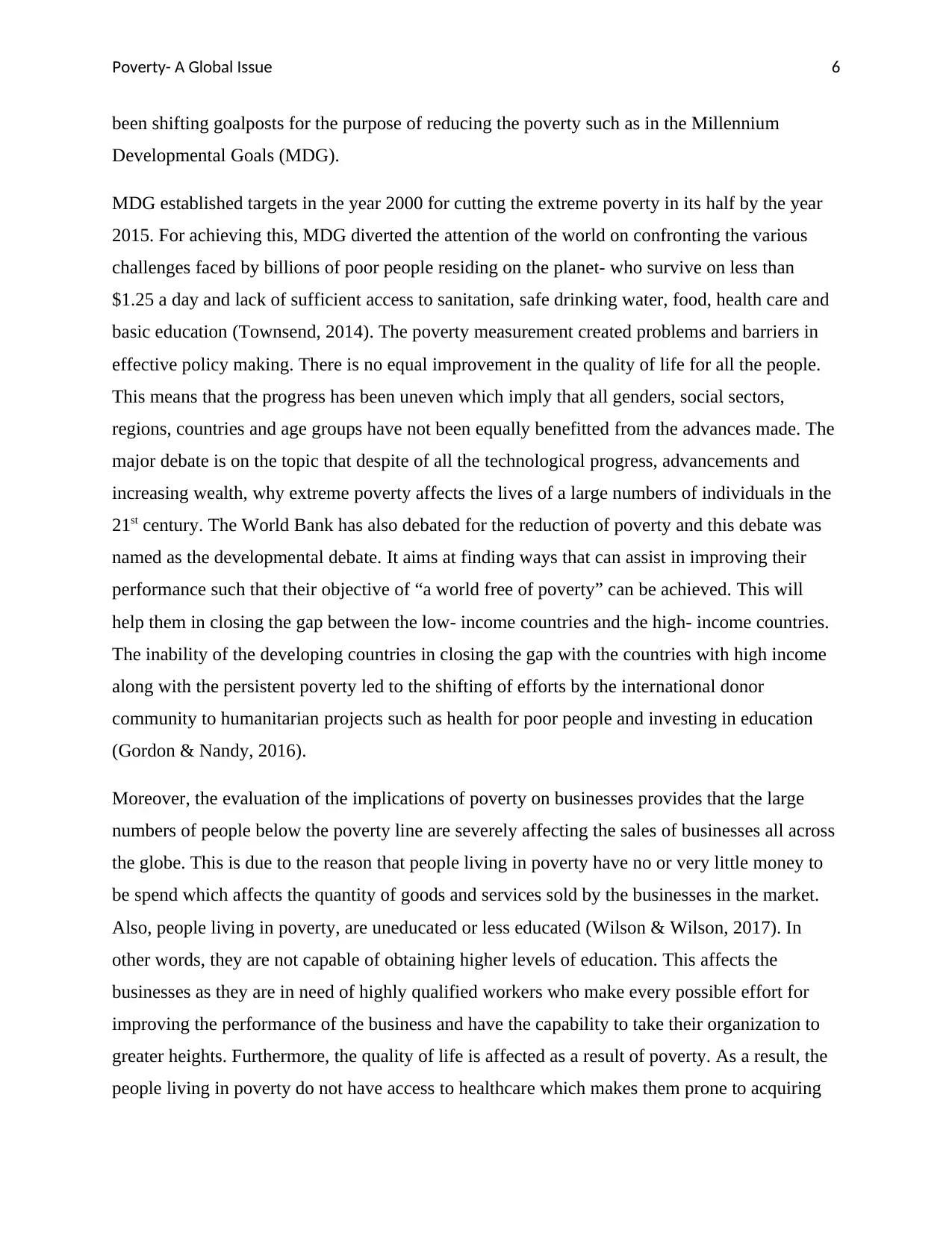
Poverty- A Global Issue 6
been shifting goalposts for the purpose of reducing the poverty such as in the Millennium
Developmental Goals (MDG).
MDG established targets in the year 2000 for cutting the extreme poverty in its half by the year
2015. For achieving this, MDG diverted the attention of the world on confronting the various
challenges faced by billions of poor people residing on the planet- who survive on less than
$1.25 a day and lack of sufficient access to sanitation, safe drinking water, food, health care and
basic education (Townsend, 2014). The poverty measurement created problems and barriers in
effective policy making. There is no equal improvement in the quality of life for all the people.
This means that the progress has been uneven which imply that all genders, social sectors,
regions, countries and age groups have not been equally benefitted from the advances made. The
major debate is on the topic that despite of all the technological progress, advancements and
increasing wealth, why extreme poverty affects the lives of a large numbers of individuals in the
21st century. The World Bank has also debated for the reduction of poverty and this debate was
named as the developmental debate. It aims at finding ways that can assist in improving their
performance such that their objective of “a world free of poverty” can be achieved. This will
help them in closing the gap between the low- income countries and the high- income countries.
The inability of the developing countries in closing the gap with the countries with high income
along with the persistent poverty led to the shifting of efforts by the international donor
community to humanitarian projects such as health for poor people and investing in education
(Gordon & Nandy, 2016).
Moreover, the evaluation of the implications of poverty on businesses provides that the large
numbers of people below the poverty line are severely affecting the sales of businesses all across
the globe. This is due to the reason that people living in poverty have no or very little money to
be spend which affects the quantity of goods and services sold by the businesses in the market.
Also, people living in poverty, are uneducated or less educated (Wilson & Wilson, 2017). In
other words, they are not capable of obtaining higher levels of education. This affects the
businesses as they are in need of highly qualified workers who make every possible effort for
improving the performance of the business and have the capability to take their organization to
greater heights. Furthermore, the quality of life is affected as a result of poverty. As a result, the
people living in poverty do not have access to healthcare which makes them prone to acquiring
been shifting goalposts for the purpose of reducing the poverty such as in the Millennium
Developmental Goals (MDG).
MDG established targets in the year 2000 for cutting the extreme poverty in its half by the year
2015. For achieving this, MDG diverted the attention of the world on confronting the various
challenges faced by billions of poor people residing on the planet- who survive on less than
$1.25 a day and lack of sufficient access to sanitation, safe drinking water, food, health care and
basic education (Townsend, 2014). The poverty measurement created problems and barriers in
effective policy making. There is no equal improvement in the quality of life for all the people.
This means that the progress has been uneven which imply that all genders, social sectors,
regions, countries and age groups have not been equally benefitted from the advances made. The
major debate is on the topic that despite of all the technological progress, advancements and
increasing wealth, why extreme poverty affects the lives of a large numbers of individuals in the
21st century. The World Bank has also debated for the reduction of poverty and this debate was
named as the developmental debate. It aims at finding ways that can assist in improving their
performance such that their objective of “a world free of poverty” can be achieved. This will
help them in closing the gap between the low- income countries and the high- income countries.
The inability of the developing countries in closing the gap with the countries with high income
along with the persistent poverty led to the shifting of efforts by the international donor
community to humanitarian projects such as health for poor people and investing in education
(Gordon & Nandy, 2016).
Moreover, the evaluation of the implications of poverty on businesses provides that the large
numbers of people below the poverty line are severely affecting the sales of businesses all across
the globe. This is due to the reason that people living in poverty have no or very little money to
be spend which affects the quantity of goods and services sold by the businesses in the market.
Also, people living in poverty, are uneducated or less educated (Wilson & Wilson, 2017). In
other words, they are not capable of obtaining higher levels of education. This affects the
businesses as they are in need of highly qualified workers who make every possible effort for
improving the performance of the business and have the capability to take their organization to
greater heights. Furthermore, the quality of life is affected as a result of poverty. As a result, the
people living in poverty do not have access to healthcare which makes them prone to acquiring
Paraphrase This Document
Need a fresh take? Get an instant paraphrase of this document with our AI Paraphraser
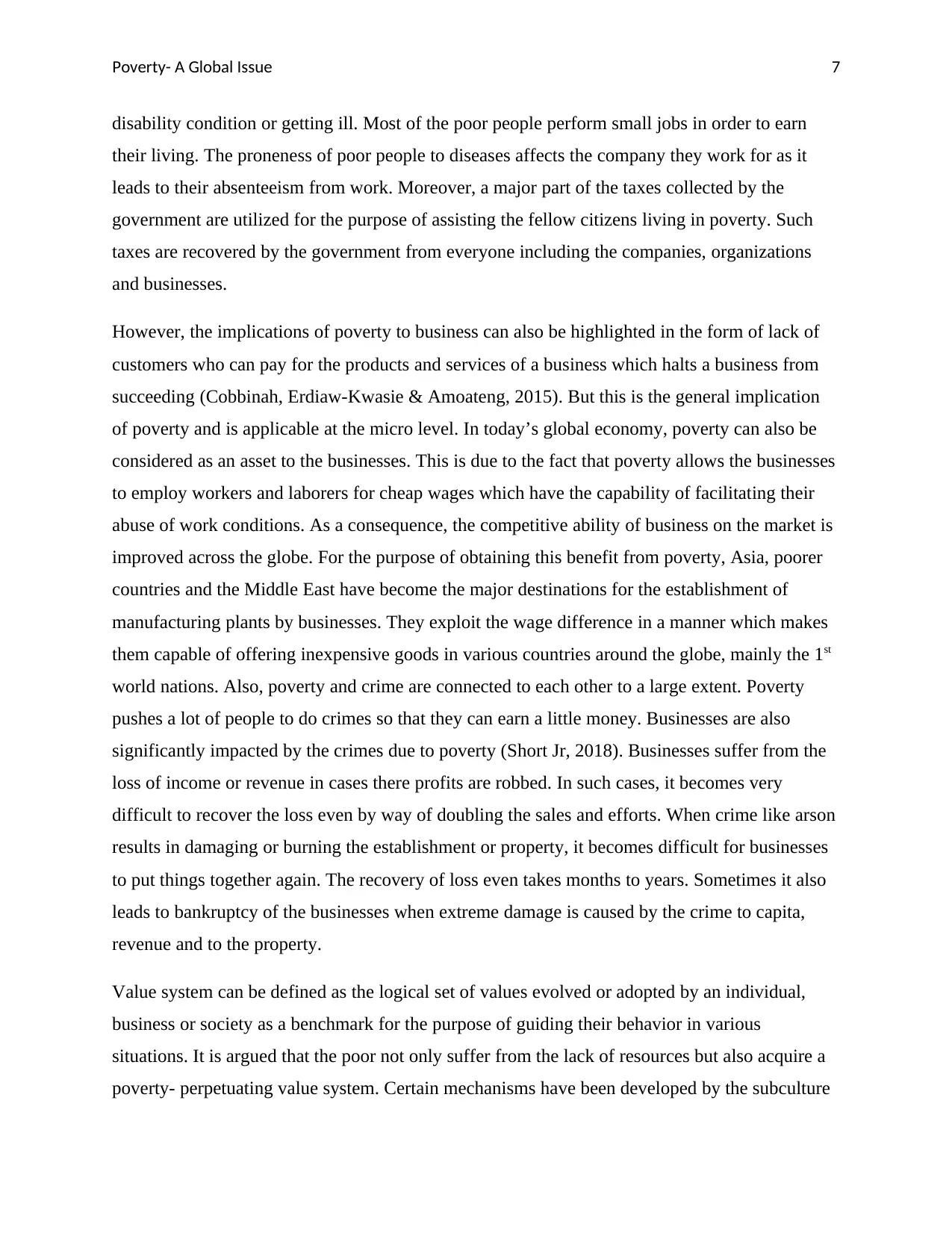
Poverty- A Global Issue 7
disability condition or getting ill. Most of the poor people perform small jobs in order to earn
their living. The proneness of poor people to diseases affects the company they work for as it
leads to their absenteeism from work. Moreover, a major part of the taxes collected by the
government are utilized for the purpose of assisting the fellow citizens living in poverty. Such
taxes are recovered by the government from everyone including the companies, organizations
and businesses.
However, the implications of poverty to business can also be highlighted in the form of lack of
customers who can pay for the products and services of a business which halts a business from
succeeding (Cobbinah, Erdiaw-Kwasie & Amoateng, 2015). But this is the general implication
of poverty and is applicable at the micro level. In today’s global economy, poverty can also be
considered as an asset to the businesses. This is due to the fact that poverty allows the businesses
to employ workers and laborers for cheap wages which have the capability of facilitating their
abuse of work conditions. As a consequence, the competitive ability of business on the market is
improved across the globe. For the purpose of obtaining this benefit from poverty, Asia, poorer
countries and the Middle East have become the major destinations for the establishment of
manufacturing plants by businesses. They exploit the wage difference in a manner which makes
them capable of offering inexpensive goods in various countries around the globe, mainly the 1st
world nations. Also, poverty and crime are connected to each other to a large extent. Poverty
pushes a lot of people to do crimes so that they can earn a little money. Businesses are also
significantly impacted by the crimes due to poverty (Short Jr, 2018). Businesses suffer from the
loss of income or revenue in cases there profits are robbed. In such cases, it becomes very
difficult to recover the loss even by way of doubling the sales and efforts. When crime like arson
results in damaging or burning the establishment or property, it becomes difficult for businesses
to put things together again. The recovery of loss even takes months to years. Sometimes it also
leads to bankruptcy of the businesses when extreme damage is caused by the crime to capita,
revenue and to the property.
Value system can be defined as the logical set of values evolved or adopted by an individual,
business or society as a benchmark for the purpose of guiding their behavior in various
situations. It is argued that the poor not only suffer from the lack of resources but also acquire a
poverty- perpetuating value system. Certain mechanisms have been developed by the subculture
disability condition or getting ill. Most of the poor people perform small jobs in order to earn
their living. The proneness of poor people to diseases affects the company they work for as it
leads to their absenteeism from work. Moreover, a major part of the taxes collected by the
government are utilized for the purpose of assisting the fellow citizens living in poverty. Such
taxes are recovered by the government from everyone including the companies, organizations
and businesses.
However, the implications of poverty to business can also be highlighted in the form of lack of
customers who can pay for the products and services of a business which halts a business from
succeeding (Cobbinah, Erdiaw-Kwasie & Amoateng, 2015). But this is the general implication
of poverty and is applicable at the micro level. In today’s global economy, poverty can also be
considered as an asset to the businesses. This is due to the fact that poverty allows the businesses
to employ workers and laborers for cheap wages which have the capability of facilitating their
abuse of work conditions. As a consequence, the competitive ability of business on the market is
improved across the globe. For the purpose of obtaining this benefit from poverty, Asia, poorer
countries and the Middle East have become the major destinations for the establishment of
manufacturing plants by businesses. They exploit the wage difference in a manner which makes
them capable of offering inexpensive goods in various countries around the globe, mainly the 1st
world nations. Also, poverty and crime are connected to each other to a large extent. Poverty
pushes a lot of people to do crimes so that they can earn a little money. Businesses are also
significantly impacted by the crimes due to poverty (Short Jr, 2018). Businesses suffer from the
loss of income or revenue in cases there profits are robbed. In such cases, it becomes very
difficult to recover the loss even by way of doubling the sales and efforts. When crime like arson
results in damaging or burning the establishment or property, it becomes difficult for businesses
to put things together again. The recovery of loss even takes months to years. Sometimes it also
leads to bankruptcy of the businesses when extreme damage is caused by the crime to capita,
revenue and to the property.
Value system can be defined as the logical set of values evolved or adopted by an individual,
business or society as a benchmark for the purpose of guiding their behavior in various
situations. It is argued that the poor not only suffer from the lack of resources but also acquire a
poverty- perpetuating value system. Certain mechanisms have been developed by the subculture
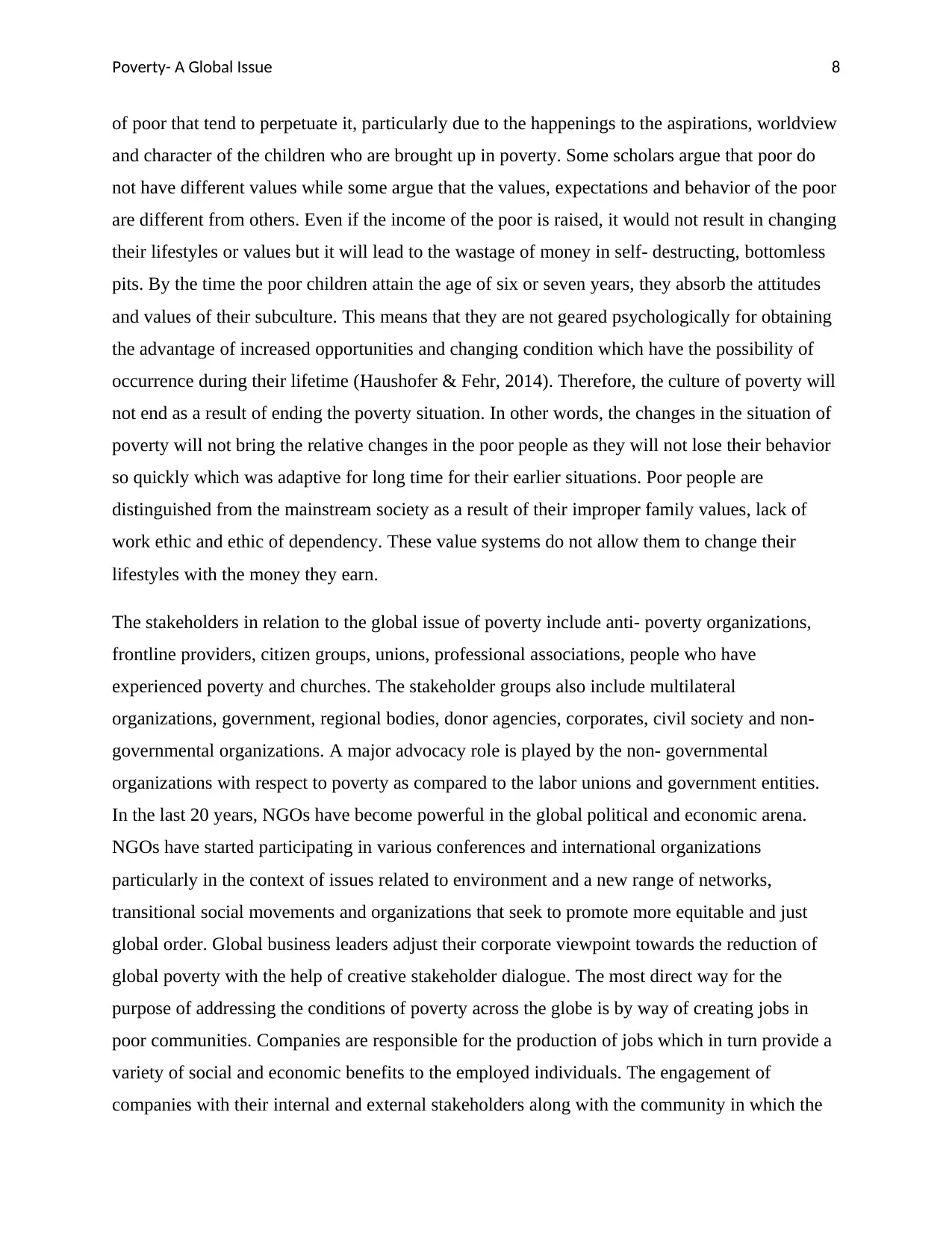
Poverty- A Global Issue 8
of poor that tend to perpetuate it, particularly due to the happenings to the aspirations, worldview
and character of the children who are brought up in poverty. Some scholars argue that poor do
not have different values while some argue that the values, expectations and behavior of the poor
are different from others. Even if the income of the poor is raised, it would not result in changing
their lifestyles or values but it will lead to the wastage of money in self- destructing, bottomless
pits. By the time the poor children attain the age of six or seven years, they absorb the attitudes
and values of their subculture. This means that they are not geared psychologically for obtaining
the advantage of increased opportunities and changing condition which have the possibility of
occurrence during their lifetime (Haushofer & Fehr, 2014). Therefore, the culture of poverty will
not end as a result of ending the poverty situation. In other words, the changes in the situation of
poverty will not bring the relative changes in the poor people as they will not lose their behavior
so quickly which was adaptive for long time for their earlier situations. Poor people are
distinguished from the mainstream society as a result of their improper family values, lack of
work ethic and ethic of dependency. These value systems do not allow them to change their
lifestyles with the money they earn.
The stakeholders in relation to the global issue of poverty include anti- poverty organizations,
frontline providers, citizen groups, unions, professional associations, people who have
experienced poverty and churches. The stakeholder groups also include multilateral
organizations, government, regional bodies, donor agencies, corporates, civil society and non-
governmental organizations. A major advocacy role is played by the non- governmental
organizations with respect to poverty as compared to the labor unions and government entities.
In the last 20 years, NGOs have become powerful in the global political and economic arena.
NGOs have started participating in various conferences and international organizations
particularly in the context of issues related to environment and a new range of networks,
transitional social movements and organizations that seek to promote more equitable and just
global order. Global business leaders adjust their corporate viewpoint towards the reduction of
global poverty with the help of creative stakeholder dialogue. The most direct way for the
purpose of addressing the conditions of poverty across the globe is by way of creating jobs in
poor communities. Companies are responsible for the production of jobs which in turn provide a
variety of social and economic benefits to the employed individuals. The engagement of
companies with their internal and external stakeholders along with the community in which the
of poor that tend to perpetuate it, particularly due to the happenings to the aspirations, worldview
and character of the children who are brought up in poverty. Some scholars argue that poor do
not have different values while some argue that the values, expectations and behavior of the poor
are different from others. Even if the income of the poor is raised, it would not result in changing
their lifestyles or values but it will lead to the wastage of money in self- destructing, bottomless
pits. By the time the poor children attain the age of six or seven years, they absorb the attitudes
and values of their subculture. This means that they are not geared psychologically for obtaining
the advantage of increased opportunities and changing condition which have the possibility of
occurrence during their lifetime (Haushofer & Fehr, 2014). Therefore, the culture of poverty will
not end as a result of ending the poverty situation. In other words, the changes in the situation of
poverty will not bring the relative changes in the poor people as they will not lose their behavior
so quickly which was adaptive for long time for their earlier situations. Poor people are
distinguished from the mainstream society as a result of their improper family values, lack of
work ethic and ethic of dependency. These value systems do not allow them to change their
lifestyles with the money they earn.
The stakeholders in relation to the global issue of poverty include anti- poverty organizations,
frontline providers, citizen groups, unions, professional associations, people who have
experienced poverty and churches. The stakeholder groups also include multilateral
organizations, government, regional bodies, donor agencies, corporates, civil society and non-
governmental organizations. A major advocacy role is played by the non- governmental
organizations with respect to poverty as compared to the labor unions and government entities.
In the last 20 years, NGOs have become powerful in the global political and economic arena.
NGOs have started participating in various conferences and international organizations
particularly in the context of issues related to environment and a new range of networks,
transitional social movements and organizations that seek to promote more equitable and just
global order. Global business leaders adjust their corporate viewpoint towards the reduction of
global poverty with the help of creative stakeholder dialogue. The most direct way for the
purpose of addressing the conditions of poverty across the globe is by way of creating jobs in
poor communities. Companies are responsible for the production of jobs which in turn provide a
variety of social and economic benefits to the employed individuals. The engagement of
companies with their internal and external stakeholders along with the community in which the
⊘ This is a preview!⊘
Do you want full access?
Subscribe today to unlock all pages.

Trusted by 1+ million students worldwide
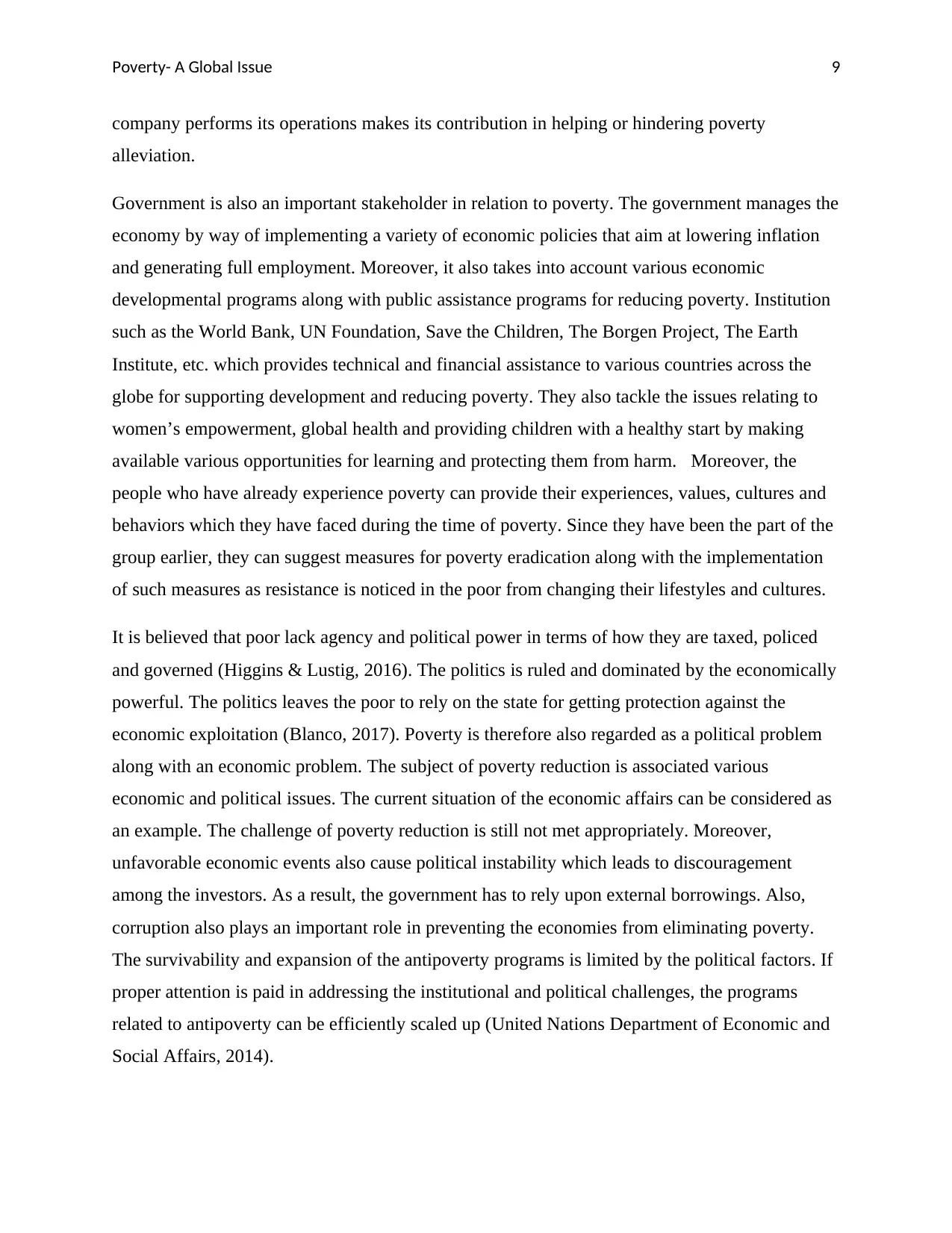
Poverty- A Global Issue 9
company performs its operations makes its contribution in helping or hindering poverty
alleviation.
Government is also an important stakeholder in relation to poverty. The government manages the
economy by way of implementing a variety of economic policies that aim at lowering inflation
and generating full employment. Moreover, it also takes into account various economic
developmental programs along with public assistance programs for reducing poverty. Institution
such as the World Bank, UN Foundation, Save the Children, The Borgen Project, The Earth
Institute, etc. which provides technical and financial assistance to various countries across the
globe for supporting development and reducing poverty. They also tackle the issues relating to
women’s empowerment, global health and providing children with a healthy start by making
available various opportunities for learning and protecting them from harm. Moreover, the
people who have already experience poverty can provide their experiences, values, cultures and
behaviors which they have faced during the time of poverty. Since they have been the part of the
group earlier, they can suggest measures for poverty eradication along with the implementation
of such measures as resistance is noticed in the poor from changing their lifestyles and cultures.
It is believed that poor lack agency and political power in terms of how they are taxed, policed
and governed (Higgins & Lustig, 2016). The politics is ruled and dominated by the economically
powerful. The politics leaves the poor to rely on the state for getting protection against the
economic exploitation (Blanco, 2017). Poverty is therefore also regarded as a political problem
along with an economic problem. The subject of poverty reduction is associated various
economic and political issues. The current situation of the economic affairs can be considered as
an example. The challenge of poverty reduction is still not met appropriately. Moreover,
unfavorable economic events also cause political instability which leads to discouragement
among the investors. As a result, the government has to rely upon external borrowings. Also,
corruption also plays an important role in preventing the economies from eliminating poverty.
The survivability and expansion of the antipoverty programs is limited by the political factors. If
proper attention is paid in addressing the institutional and political challenges, the programs
related to antipoverty can be efficiently scaled up (United Nations Department of Economic and
Social Affairs, 2014).
company performs its operations makes its contribution in helping or hindering poverty
alleviation.
Government is also an important stakeholder in relation to poverty. The government manages the
economy by way of implementing a variety of economic policies that aim at lowering inflation
and generating full employment. Moreover, it also takes into account various economic
developmental programs along with public assistance programs for reducing poverty. Institution
such as the World Bank, UN Foundation, Save the Children, The Borgen Project, The Earth
Institute, etc. which provides technical and financial assistance to various countries across the
globe for supporting development and reducing poverty. They also tackle the issues relating to
women’s empowerment, global health and providing children with a healthy start by making
available various opportunities for learning and protecting them from harm. Moreover, the
people who have already experience poverty can provide their experiences, values, cultures and
behaviors which they have faced during the time of poverty. Since they have been the part of the
group earlier, they can suggest measures for poverty eradication along with the implementation
of such measures as resistance is noticed in the poor from changing their lifestyles and cultures.
It is believed that poor lack agency and political power in terms of how they are taxed, policed
and governed (Higgins & Lustig, 2016). The politics is ruled and dominated by the economically
powerful. The politics leaves the poor to rely on the state for getting protection against the
economic exploitation (Blanco, 2017). Poverty is therefore also regarded as a political problem
along with an economic problem. The subject of poverty reduction is associated various
economic and political issues. The current situation of the economic affairs can be considered as
an example. The challenge of poverty reduction is still not met appropriately. Moreover,
unfavorable economic events also cause political instability which leads to discouragement
among the investors. As a result, the government has to rely upon external borrowings. Also,
corruption also plays an important role in preventing the economies from eliminating poverty.
The survivability and expansion of the antipoverty programs is limited by the political factors. If
proper attention is paid in addressing the institutional and political challenges, the programs
related to antipoverty can be efficiently scaled up (United Nations Department of Economic and
Social Affairs, 2014).
Paraphrase This Document
Need a fresh take? Get an instant paraphrase of this document with our AI Paraphraser
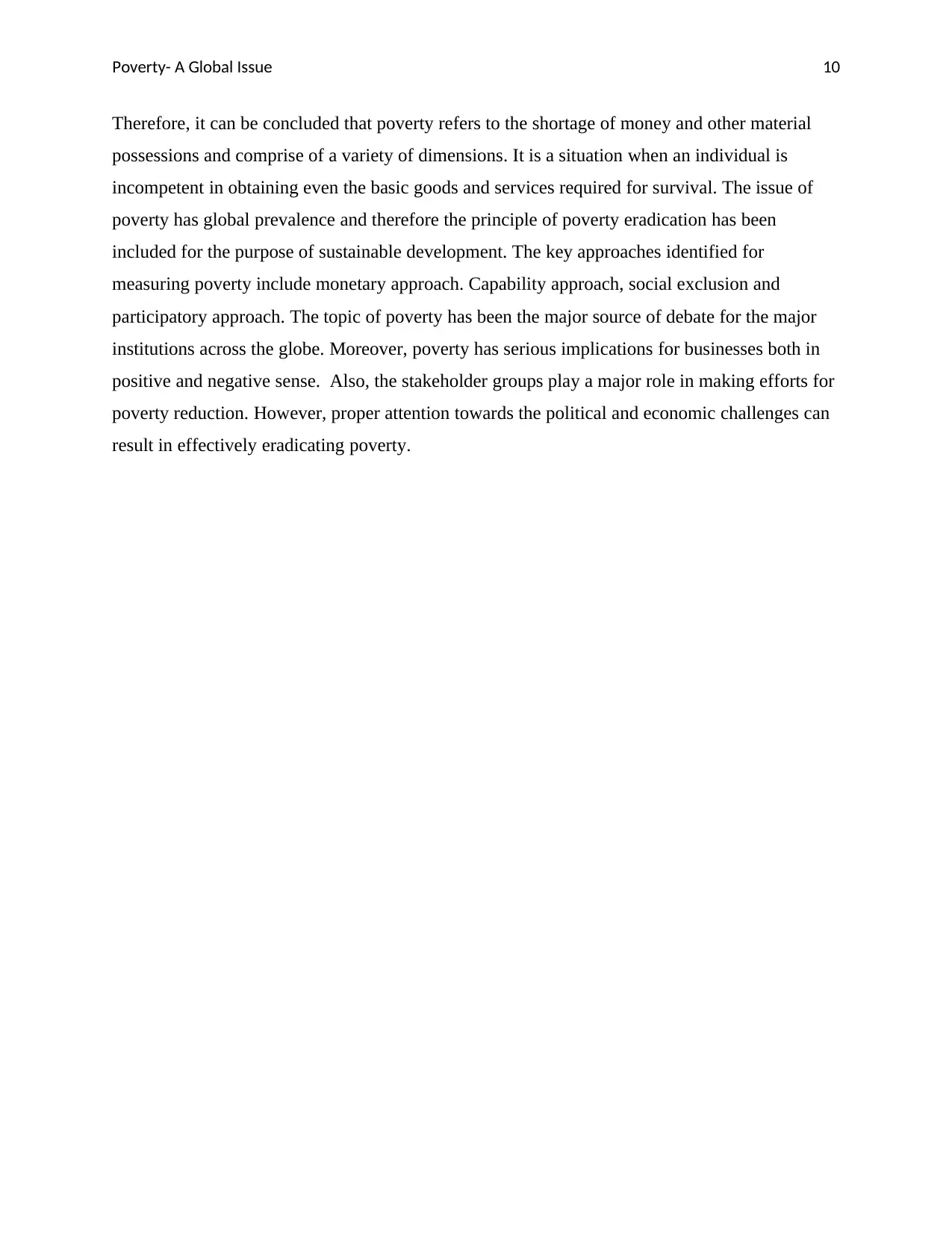
Poverty- A Global Issue 10
Therefore, it can be concluded that poverty refers to the shortage of money and other material
possessions and comprise of a variety of dimensions. It is a situation when an individual is
incompetent in obtaining even the basic goods and services required for survival. The issue of
poverty has global prevalence and therefore the principle of poverty eradication has been
included for the purpose of sustainable development. The key approaches identified for
measuring poverty include monetary approach. Capability approach, social exclusion and
participatory approach. The topic of poverty has been the major source of debate for the major
institutions across the globe. Moreover, poverty has serious implications for businesses both in
positive and negative sense. Also, the stakeholder groups play a major role in making efforts for
poverty reduction. However, proper attention towards the political and economic challenges can
result in effectively eradicating poverty.
Therefore, it can be concluded that poverty refers to the shortage of money and other material
possessions and comprise of a variety of dimensions. It is a situation when an individual is
incompetent in obtaining even the basic goods and services required for survival. The issue of
poverty has global prevalence and therefore the principle of poverty eradication has been
included for the purpose of sustainable development. The key approaches identified for
measuring poverty include monetary approach. Capability approach, social exclusion and
participatory approach. The topic of poverty has been the major source of debate for the major
institutions across the globe. Moreover, poverty has serious implications for businesses both in
positive and negative sense. Also, the stakeholder groups play a major role in making efforts for
poverty reduction. However, proper attention towards the political and economic challenges can
result in effectively eradicating poverty.
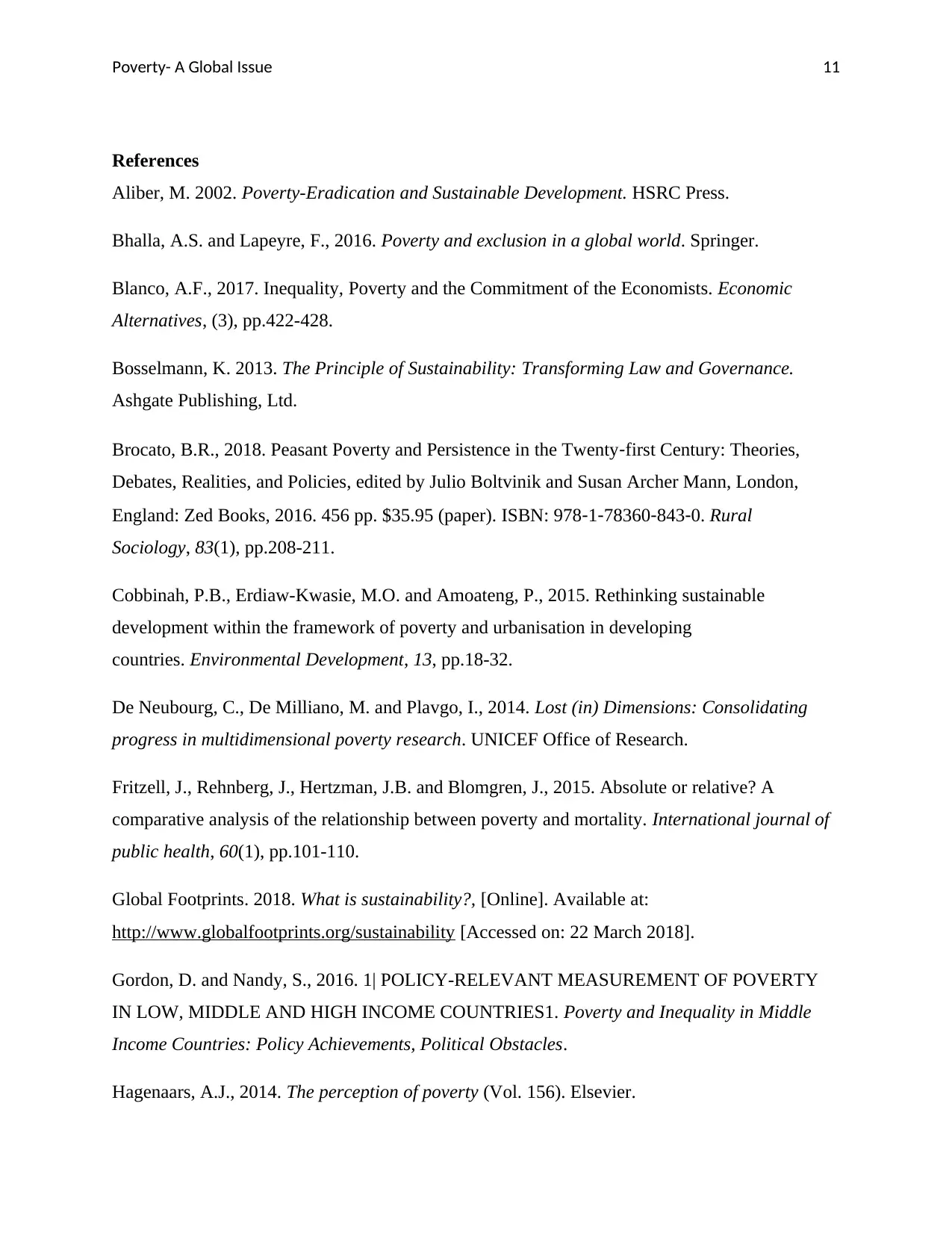
Poverty- A Global Issue 11
References
Aliber, M. 2002. Poverty-Eradication and Sustainable Development. HSRC Press.
Bhalla, A.S. and Lapeyre, F., 2016. Poverty and exclusion in a global world. Springer.
Blanco, A.F., 2017. Inequality, Poverty and the Commitment of the Economists. Economic
Alternatives, (3), pp.422-428.
Bosselmann, K. 2013. The Principle of Sustainability: Transforming Law and Governance.
Ashgate Publishing, Ltd.
Brocato, B.R., 2018. Peasant Poverty and Persistence in the Twenty‐first Century: Theories,
Debates, Realities, and Policies, edited by Julio Boltvinik and Susan Archer Mann, London,
England: Zed Books, 2016. 456 pp. $35.95 (paper). ISBN: 978‐1‐78360‐843‐0. Rural
Sociology, 83(1), pp.208-211.
Cobbinah, P.B., Erdiaw-Kwasie, M.O. and Amoateng, P., 2015. Rethinking sustainable
development within the framework of poverty and urbanisation in developing
countries. Environmental Development, 13, pp.18-32.
De Neubourg, C., De Milliano, M. and Plavgo, I., 2014. Lost (in) Dimensions: Consolidating
progress in multidimensional poverty research. UNICEF Office of Research.
Fritzell, J., Rehnberg, J., Hertzman, J.B. and Blomgren, J., 2015. Absolute or relative? A
comparative analysis of the relationship between poverty and mortality. International journal of
public health, 60(1), pp.101-110.
Global Footprints. 2018. What is sustainability?, [Online]. Available at:
http://www.globalfootprints.org/sustainability [Accessed on: 22 March 2018].
Gordon, D. and Nandy, S., 2016. 1| POLICY-RELEVANT MEASUREMENT OF POVERTY
IN LOW, MIDDLE AND HIGH INCOME COUNTRIES1. Poverty and Inequality in Middle
Income Countries: Policy Achievements, Political Obstacles.
Hagenaars, A.J., 2014. The perception of poverty (Vol. 156). Elsevier.
References
Aliber, M. 2002. Poverty-Eradication and Sustainable Development. HSRC Press.
Bhalla, A.S. and Lapeyre, F., 2016. Poverty and exclusion in a global world. Springer.
Blanco, A.F., 2017. Inequality, Poverty and the Commitment of the Economists. Economic
Alternatives, (3), pp.422-428.
Bosselmann, K. 2013. The Principle of Sustainability: Transforming Law and Governance.
Ashgate Publishing, Ltd.
Brocato, B.R., 2018. Peasant Poverty and Persistence in the Twenty‐first Century: Theories,
Debates, Realities, and Policies, edited by Julio Boltvinik and Susan Archer Mann, London,
England: Zed Books, 2016. 456 pp. $35.95 (paper). ISBN: 978‐1‐78360‐843‐0. Rural
Sociology, 83(1), pp.208-211.
Cobbinah, P.B., Erdiaw-Kwasie, M.O. and Amoateng, P., 2015. Rethinking sustainable
development within the framework of poverty and urbanisation in developing
countries. Environmental Development, 13, pp.18-32.
De Neubourg, C., De Milliano, M. and Plavgo, I., 2014. Lost (in) Dimensions: Consolidating
progress in multidimensional poverty research. UNICEF Office of Research.
Fritzell, J., Rehnberg, J., Hertzman, J.B. and Blomgren, J., 2015. Absolute or relative? A
comparative analysis of the relationship between poverty and mortality. International journal of
public health, 60(1), pp.101-110.
Global Footprints. 2018. What is sustainability?, [Online]. Available at:
http://www.globalfootprints.org/sustainability [Accessed on: 22 March 2018].
Gordon, D. and Nandy, S., 2016. 1| POLICY-RELEVANT MEASUREMENT OF POVERTY
IN LOW, MIDDLE AND HIGH INCOME COUNTRIES1. Poverty and Inequality in Middle
Income Countries: Policy Achievements, Political Obstacles.
Hagenaars, A.J., 2014. The perception of poverty (Vol. 156). Elsevier.
⊘ This is a preview!⊘
Do you want full access?
Subscribe today to unlock all pages.

Trusted by 1+ million students worldwide
1 out of 14
Related Documents
Your All-in-One AI-Powered Toolkit for Academic Success.
+13062052269
info@desklib.com
Available 24*7 on WhatsApp / Email
![[object Object]](/_next/static/media/star-bottom.7253800d.svg)
Unlock your academic potential
Copyright © 2020–2025 A2Z Services. All Rights Reserved. Developed and managed by ZUCOL.





